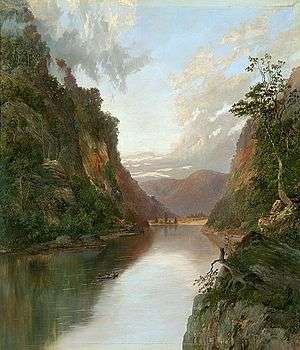William Piguenit
| William Piguenit | |
|---|---|
| Born |
August 27, 1836 Hobart, Tasmania, Australia |
| Died |
July 17, 1914 (aged 77) Hunters Hill, Sydney, New South Wales, Australia |
| Other names | WC Piguenit |
| Known for | Painting |

William Charles Piguenit (27 August 1836 – 17 July 1914) was an Australian landscape painter.
Early life
Piguenit was born in Hobart, Tasmania, to Frederick Le Geyt Piguenit and Mary Ann née Igglesden. Frederick had been transported to Van Diemen's Land in 1830, with Frederick's fiancee, Mary Ann, following him. They married in Hobart in 1833 [1]
William’s first artistic influences came from his mother, who set up a school for young ladies where she taught "French, music and drawing".
In 1850 William became a draftsman with the Tasmanian Lands & Survey Department, working in particular on the Geological Survey of Tasmania.
During this period of employment Piguenit provided lithographic illustrations for, The Salmon Ponds and vicinity, New Norfolk Tasmania (Hobart Town: M.L. Henn, [1867]).
He took painting lessons from the Scottish painter Frank Dunnett but until he got a good price for a painting from Sir James Agnew, he had little success as a painter.
Piguenit left the public service in 1873 to devote his time more fully to painting and his oils and watercolours of Tasmanian landscapes soon brought favourable reviews.
He was a participant in the venture to the western part of Tasmania - as found in the book Walk to the West.
New South Wales
After moving to NSW in 1880 Piguenit's subjects included the Darling, Nepean and Hawkesbury Rivers as well as the Lane Cove River close to his Hunters Hill home. It was also at this time that he became one of the founders of the Art Society of New South Wales.
Later, during a visit to Tasmania he was noticed by the governor's wife, Lady Hamilton and a large number of his drawings were purchased by the government for the Hobart gallery.
His Flood in the Darling[2] was purchased for the National Art Gallery of New South Wales (now Art Gallery of New South Wales) in 1895. In 1898 and 1900 he visited Europe, exhibiting at London and Paris. Returning to Australia he won the Wynne Prize in 1901 with his Thunder storm on the Darling,[3] then in 1903 he was commissioned by the National Art Gallery of New South Wales trustees to paint Mount Kosciusko.[4]
By the end of the century he was regarded as the leading Australian-born landscape painter.
Piguenit died on 17 July 1914 and was buried in the Field of Mars cemetery. Inscription on headstone (Field of Mars Cemetery: C of E, Sec. C. Grave 618): IN LOVING MEMORY OF WILLIAM CHARLES PIGUENIT DIED 17th JULY 1914; AGED 77 YEARS. "UNTO THE UPRIGHT THERE ARISETH LIGHT IN THE DARKNESS"
Collections
Art Gallery of New South Wales
Art Gallery of South Australia
- Hell's Gates, Davey River, Tasmania, 1871
- Near Liverpool, New South Wales, c.1908
- On the Nepean, New South Wales, n.d.
- Mt. Olympus, Lake St. Clair, Tasmania, 1878
- On the Craycroft (i.e. Cracroft), Tasmania, 1878
- Tasmanian landscape, c. 1880
- Mount King William from Lake George, Tasmania, 1887
- On the Derwent, n.d.
- In the Grose Valley, 1887
- Lane Cove from below the Bridge, near Sydney N.S.Wales, n.d.
Tasmanian Museum and Art Gallery (TMAG)
Notes
- ↑ W.C. Piguenit of Hunters Hill at www.ryde.nsw.gov.au
- ↑ Piguenit, WC (1895). "The flood in the Darling 1890". AGNSW collection record. Art Gallery of New South Wales. Retrieved 10 May 2016.
- ↑ "Wynne Prize". AGNSW prize record. Art Gallery of New South Wales. 1901. Retrieved 10 May 2016.
- ↑ Piguenit, WC (1903). "Kosciusko". AGNSW collection record. Art Gallery of New South Wales. Retrieved 10 May 2016.
Resources
Account of trips from Hobart Town to Port Davey 14 February 1871 – 9 March 1871, from Hobart Town to Lake St. Clair 8 Feb. 1873-10 Mar. 1873 and from Hobart Town to Queensland 13 September 1875 – 13 October 1875, including i.a. notes concerning sketches, photographs and landscape scenery.
External links
- WC Piguenit at the Art Gallery of New South Wales
- Serle, Percival (1949). "Piguenit, William Charles". Dictionary of Australian Biography. Sydney: Angus and Robertson.
- Webberley, Helen. Tasmanian Geographic Vol 11, 2014.